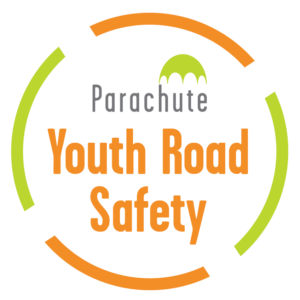The Canadian Youth Road Safety program provides year-round opportunities to partner with young leaders as key stakeholders in road safety.
Over the past several years, Parachute’s youth programs have been focused on teen drivers and driving behaviour. While there is a need for safe drivers on our roads, there is a much larger set of factors at play when it comes to youth road safety.
Through the For Young Drivers, By Young Drivers project in 2022-23, Parachute engaged around 300 youth and 11 youth engagement experts to understand young people’s attitudes and perceptions regarding road safety and their preferred methods of engagement. This led to a shift in Parachute’s approach, moving beyond driving behaviour to focus on youth partnership and meaningful youth engagement.
The Canadian Youth Road Safety Program engages youth year-round through the Canadian Youth Road Safety Council, the Youth Ambassadors program and Canadian Youth Road Safety Week (formerly National Teen Drivers Safety Week), held annually in the third full week of October.
Why youth are at greater risk of road crashes
Youth and young adults are killed in road crashes at a higher rate than any other age group under 75 years old. With road crashes being the third-leading cause of death among people aged 15 to 24 years old, this age demographic has the highest rate of involvement in fatal collisions per 100,000 licensed drivers. Here are some reasons that youth are at greater risk of road crashes:
- Peer influence can encourage unsafe driving behaviours, such as speeding or impaired driving.
- Young people’s brains are still developing until the age of 25, and this can affect judgement, organization, decision-making and increase the risk of impulsive actions, all of which play a role in risky driving behaviour.
- Youth may have less awareness of the risks of multitasking while driving.
- Young people may have limited driving experience, meaning that it can take some time for them to understand road rules, learn to safely handle dangerous driving situations and gain a strong ability to control the vehicle.
Due to these reasons, young drivers are exposed to more risks while driving, but Vision Zero does not blame people for making mistakes, and we shouldn’t either. There is a need for safer road systems to protect Canadians when mistakes do happen and the need for youth voices to be part of the solution.
Youth participation in road safety
Youth are the experts of their experiences and, with the right support, they can be influential partners in road safety. By engaging in road safety, young people can further develop skills such as leadership and decision-making, as well as learn how to positively impact their communities.
Here are some ways to engage young people in road safety issues:
- Encourage youth to participate in decision-making to make the shift from labelling young people as victims or troublemakers to changemakers and engaged community members.
- Provide young people with road safety information and programming in engaging, enjoyable and accessible ways.
- Focus on providing strategies that eliminate risk and harm of alcohol, cannabis or other drugs while on the road, rather than promoting an abstinence-only model to youth.
- Consider equity, diversity, inclusion and accessibility in your road safety messaging and programming to ensure that diverse needs are being met.
Youth engagement in road safety
When youth come together to support road safety, it can shift the conversation from focusing on how a person drives to how roads can be safer for everyone. Youth engagement in road safety leads to healthier and safer youth, opportunities to develop their skills, and contribute positively to their communities. Youth can also have positive peer influence on one another through encouraging safe driving, raising awareness on positive changes to the road systems, and joining civic action on a broader scale.
Some road safety concerns that young people have, and can advocate for, include:
- Infrastructure changes in their communities, such as installing speed bumps, bicycle lanes, or addition of a crossing guard to a school zone.
- Improved active transportation options, such as installing e-bike and e-scooter stations, adding better lighting at intersections and bus stops in underserved communities.
- Working with enforcement on positive ticketing campaigns.
- Greater and more equitable driver education access.
There are many ways for young people to get involved in advocating for safer roads:
- Lead their own advocacy campaign, such as letter writing, collaborating with local representatives, and encouraging their peers to learn more about road safety.
- Spread road safety information through social media, attending and organizing youth-led safety events and town halls, and talking with their peers.
- Share with organizations and decision-makers how they would like to improve road safety in their communities, resources that young people need to create safer roads and how they would like to receive road safety information.
- Learning about and using local reporting systems for sidewalk and road maintenance or requesting the addition of safety measures like bike lane markings or flashing lights in their neighbourhoods.
Youth safety and Vision Zero
Vision Zero is the philosophy that road fatalities and serious injuries are unacceptable and can and should be eliminated while providing safe, healthy and equitable mobility for all road users. As we shift the conversation and begin to recognize youth as powerful stakeholders in road safety, youth are encouraged to advocate for Vision Zero and Safe Systems Approaches to create safer roads for them, their families and communities. To learn more about Vision Zero, visit: parachute.ca/visionzero


